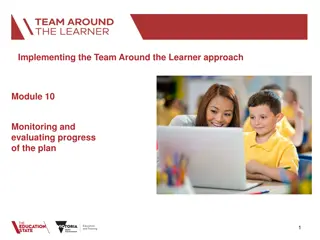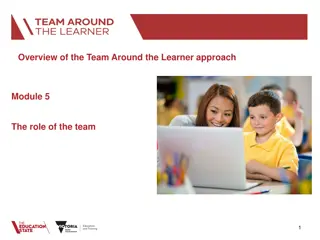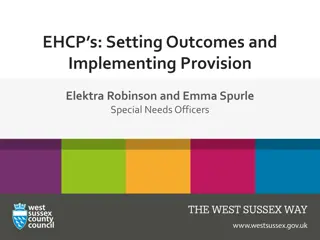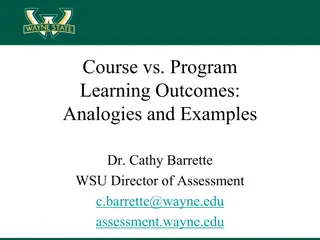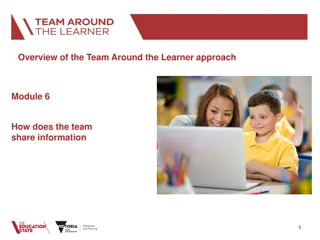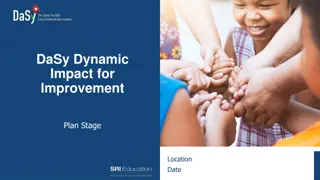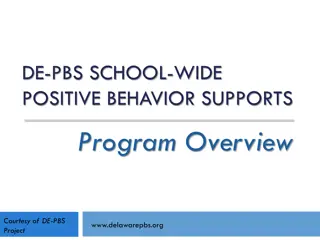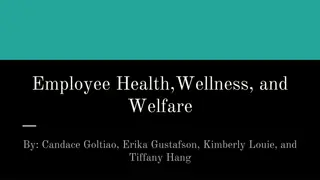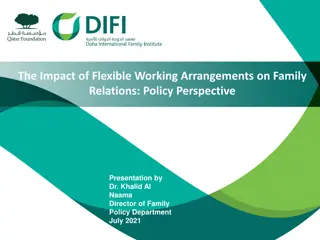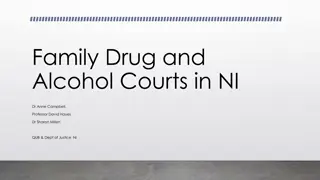Achieving Positive Outcomes Through Team Around the Family Approach
In Ysgol Coedcae School, the Team Around the Family (TAF) approach focuses on addressing vulnerabilities like low attainment and attendance, high exclusion rates, and low self-esteem among pupils. The aim is to increase school attendance, promote social engagement, reduce referrals to specialist agencies, and prevent young people from entering the justice system. The key features of TAF include being family-focused, bespoke, integrated, proactive, and solution-focused. Various agencies like health professionals, school staff, parenting support agencies, social workers, and youth services collaborate in this multi-agency approach to provide tailored support. Weekly meetings at the school involve discussions on prioritizing needs and identifying appropriate services to help families effectively.
Uploaded on Feb 18, 2025 | 2 Views
Download Presentation

Please find below an Image/Link to download the presentation.
The content on the website is provided AS IS for your information and personal use only. It may not be sold, licensed, or shared on other websites without obtaining consent from the author.If you encounter any issues during the download, it is possible that the publisher has removed the file from their server.
You are allowed to download the files provided on this website for personal or commercial use, subject to the condition that they are used lawfully. All files are the property of their respective owners.
The content on the website is provided AS IS for your information and personal use only. It may not be sold, licensed, or shared on other websites without obtaining consent from the author.
E N D
Presentation Transcript
Ysgol Coedcae School Team around the family (TAF)
School context Mixed, 11-16 comprehensive, urban area of Llanelli 900 pupils 24.6% FSM 48% cohort living in 20% most deprived areas in Wales All Wales Core Data - family 9
In-school strategies Leadership PDG Data Listening to learners & parents/carers Curriculum Attendance & behaviour
Need for TAF in Coedcae School Vulnerability of pupils Low attainment Low attendance High exclusion rate Low self-esteem Frustration of staff - Disenfranchisement - Inefficiency of systems
Aims of TAF Increase school attendance for vulnerable learners Increase social engagement and inclusion Reduce inappropriate referral to specialist agencies Reduce NEET Reduce first-time entrants into youth justice system Reduce number of LAC Reduce number leaving school without qualifications
What is a TAF approach? A TAF approach is a multi-agency, co-ordinated approach that involves a number of identified agencies working together to deliver a single plan of support to a family, at an early stage of family need
Key features of TAF Family focused Bespoke Integrated Proactive Local Solution focused
Who is involved? Health professional School Nurse Parenting support agencies School FAMILY Social worker FEW Young carers service Youth service
The process Weekly meetings, at school, chaired by school staff Referral: by school by external agency/school partner by the family
The process Cases presented Panel discussion Needs prioritised and appropriate service identified to support Relevant agency accepts caseload Updates of live caseloads reviewed
Case study A REASON FOR REFERRAL A was very unhappy at school at start of new term, finding it very difficult to settle, despite achieving an excellent 98.6% attendance rate the previous term. Work was beginning to slip. Pupil complained that he was being bullied. Mum was contacted and all pupils causing concern to A engaged in restorative justice. All issues were resolved but A continued to be unhappy. Further interviews with Mum disclosed a history that was not known to the school, whereby A was incredibly sensitive due to incidents in primary school, linked to family situation. SEAL programme and referral to TAF were agreed. UNDER TAF Social worker and nurse met with family and offered their support to parents, providing strategies in dealing with very low self-esteem SEAL curriculum was extended to 1:1 work with youth worker and attendance on a gardening project to meet other pupils and raise confidence. STAR project has counselled pupil in what makes a healthy relationship where everyone is equal. OUTCOMES Participates well with SEAL curriculum, reasoning with feelings and engaging with strategies to cope more positively Developed existing and established new friendship groups Achieving global grade in all subjects and exceeding in three Mum reports that he s much happier and settled at home Awarded key role in this year s school show Attendance maintained
Case study B REASON FOR REFERRAL Pupil B was presenting an attendance concern averaging 46%. Referral to TAF as pupil was failing to return home during evenings, police involvement, unsavoury relationships. Consent gained from home visit as mum was very unwell. UNDER TAF School-based social worker took on the case; working with family disclosed a past that involved domestic violence Due to mum s ill health, Women s Aid engaged with the family, the STAR project provided B with strategies to form healthy relationships. Our youth worker placed B on a number of projects that aimed to raise self- esteem and develop positive relationships. This was facilitated with 1:1 support. OUTCOMES Improved attendance - already 81%. B is happy at school, has a good friendship circle and is achieving her global grade in 90% of her subjects. Sadly, B s mum has recently passed away. The success of the support is such that B is continuing to engage in all projects and making further progress with attendance and academic attainment. The partnership work has proved that open communication, honesty and trust can only maximise opportunity
Case study C REASON FOR REFERRAL C was achieving 85% attendance and often late for school. Negative behaviour points on the increase with a negative attitude to learning. Mum reported bad behaviour at home, failure to comply with household routines, argumentative and sometimes violent towards siblings. UNDER TAF School nurse and social worker engaged with pupil and family. Focused interviews and health checks with a referral to the health clinic revealed previously-undiagnosed sleeping disorder. Medication has been prescribed. OUTCOMES C is now on time for school Attendance has gone from 85% to 94% Latest progress review revealed vast improvements in concentration, behaviour and learning. Improvements in the majority of subjects Home life is much calmer, sleeping well and eager to come to school.
Case study D REASON FOR REFERRAL Pupil D was refusing to come to school. There appeared no reason that was obvious to home or school. Previous learning was successful, with high attainment. Every effort made by parents and pupil support team led to attendance decreasing further. Our youth projects failed to engage and disaffection became a major concern. Attendance was half a day a week over a three- week period when intervention began. Such attendance affected the whole family, having a negative impact on the working lives and earning capacity of both parents, in addition to a negative impact on the general wellbeing of younger siblings and their refusal to go to school. UNDER TAF School nurse and social worker engaged with pupil and family. Regular home visits from the pupil support team, nurse and social worker led to a diagnosis of Autistic Spectrum Disorder. OUTCOMES Avoided attendance prosecutions with early intervention Referral to PRU attendance now 100% and engaging very well Parents received appropriate support FACT support Working towards a return to mainstream
Impact of TAF Attendance 2011 89.6% (4th) 2012 90.1% (4th) 2013 92.2% (1st) Exclusions & EOTAS referrals Significantly reduced Emotional wellbeing EL scores improved post TAF intervention
Impact of TAF Attainment L2 L2+ CSI L1 CPS 2011 49% 37% 37% 87% 276 2012 72% 44% 43% 95% 325 2013 84% 46% 43% 94% 338
Way forward Cross-phase TAF Extend involvement of external agencies Improve transition when support coming to an end






